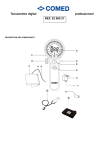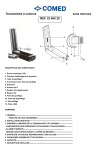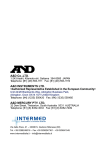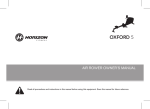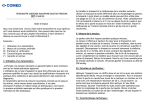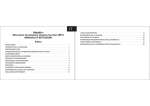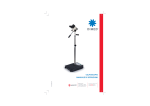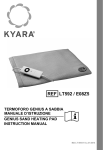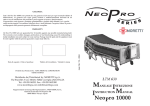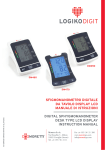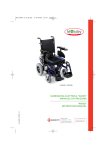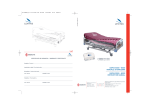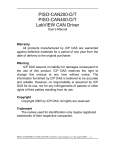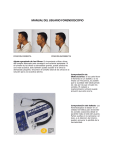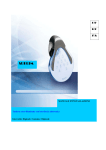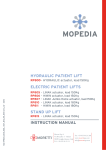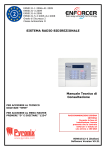Download MA DM344-349-361-362-366-367-370 02 A eng/ita
Transcript
MA DM344-349-361-362-366-367-370 02 A_04-2011 Sfigmomanometri ad aneroide manuale di istruzioni ANEROID SPHYGMOMANOMETERs INSTRUCTION MANUAL MA DM344-349-361-362-366-367-370 02 A eng/ita.indd 1 Moretti S.p.A. Via Bruxelles 3 - Meleto 52022 Cavriglia (Arezzo) Tel. +39 055 96 21 11 Fax +39 055 96 21 200 www.morettispa.com [email protected] 04/05/12 10:18 2 ITALIANO Dispositivo Medico di classe I con funzioni di misura D.Lgs 24/02/97 n.46 attuazione della direttiva CEE 93/42 e successive modifiche CODICI DM344....................... Sfigmomanometro aneroide palmare kit 3 bracciali DM349....................... Sfigmomanometro aneroide palmare a 2 tubi standard DM361........................ Sfigmomanometro aneroide da parete con cestello DM362....................... Sfigmomanometro aneroide da parete con vaschetta DM366....................... Sfigmomanometro aneroide su stativo con cestello DM367........................ Sfigmomanometro aneroide su stativo con vaschetta DM370........................Sfigmomanometro aneroide da tavolo INTRODUZIONE Grazie per aver scelto uno sfigmomanometro aneroide della linea LOGIKO by Moretti. Gli sfigmomanometri LOGIKO by Moretti sono stati progettati e realizzati per soddisfare tutte le vostre esigenze per un utilizzo pratico, corretto e sicuro. Questo manuale contiene dei piccoli suggerimenti per un corretto uso del dispositivo da voi scelto e dei preziosi consigli per la vostra sicurezza. Si consiglia di leggere attentamente la totalità del presente manuale prima di usare lo sfigmomanometro aneroide. In caso di dubbi vi preghiamo di contattare il rivenditore, il quale saprà aiutarvi e consigliarvi correttamente. DESTINAZIONE D’USO Gli sfigmomanometri aneroidi della linea LOGIKO by Moretti sono dispositivi per la misurazione della pressione del sangue e lavorano in modo auscultatorio secondo il metodo Riva Rocci/Korotkoff. DESCRIZIONE GENERALE La pressione d’aria nel bracciale, necessaria per la misurazione,viene creata mediante una monopalla. La valvola di sfiato permette una fine regolazione dell’uscita dell’aria dal bracciale consentendo la misurazione. Ogni manometro ha una scala di lettura con un campo di misurazione da 0 a 300 mmHg (mmHg= millimetri di mercurio) con suddivisione di 2 mmHg e tacche maggiori ogni 10 mmHg per una facile lettura. La precisione di lettura in tutto il campo è di +/- 3 mmHg. Con questo sistema viene misurata sia la pressione SISTOLICA che la pressione DIASTOLICA. CHE COSA E’ LA PRESSIONE DEL SANGUE? La pressione sanguigna è la pressione esercitata dal sangue sulle pareti dei vasi sanguigni. La pressione massima nelle arterie durante il ciclo cardiaco è definita come pressione SISTOLICA, mentre la pressione piu’ bassa è definita come pressione DIASTOLICA. QUAL’È UNA NORMALE PRESSIONE DEL SANGUE? È necessario sapere che la pressione arteriosa è sottoposta a forti fluttuazioni. Il livello della pressione arteriosa dipende da molti fattori. Generalmente la pressione arteriosa è più bassa in estate e più alta in inverno. La pressione arteriosa puó variare con la pressione atmosferica, ed è notevolmente influenzata ad esempio da carichi fisici, eccitabilità emotiva, stress, pasti, medicinali, alcool, fumo, età ecc… Si raccomanda di scrivere le misurazioni quotidiane, in modo tale da consultare un medico per definire in modo appropriato un valore di pressione normale per il proprio organismo. N.B. La pressione del sangue varia con l’etă, quindi è necessario consultare il medico per definire una pressione normale per voi. In nessun caso dovrete modificare il dosaggio di eventuali farmaci prescritti dal medico! NORME E DIRETTIVE DI RIFERIMENTO Gli sfigmomanometri LOGIKO by Moretti sono costruiti in conformita’ alla vigente norma EN 1060-1-2: EN 1060-1 Sfigmomanometri non invasivi, requisiti generali; EN 1060-2Sfigmomanometri non invasivi, requisiti supplementari per sfigmomanometri meccanici. AVVERTENZE PER L’UTILIZZO Per un utilizzo corretto del dispositivo fare riferimento attentamente al presente manuale. Seguire sempre le indicazioni riguardanti il prodotto da voi acquistato. Tenere il dispositivo sempre lontano dalla portata dei bambini. Non portare mai la pressione oltre 300mmHg. MA DM344-349-361-362-366-367-370 02 A eng/ita.indd 2 04/05/12 10:18 3 ITALIANO MONTAGGIO GENERALE DELLE PARTI SFIGMOMANOMETRO ANEROIDE A 2 TUBI - Collegare un tubo della camera d’aria al manometro e l’altro tubo alla monopalla con rubinetto di regolazione della pressione. SFIGMOMANOMETRO ANEROIDE PALMARE A 1 TUBO - Collegare il tubo della camera d’aria al relativo attacco sullo sfigmomanometro aneroide palmare. SFIGMOMANOMETRO ANEROIDE PALMARE A 2 TUBI - Collegare un tubo della camera d’aria ad uno dei due attacchi presenti sullo sfigmomanometro palmare. Collegare l’altro tubo al restante attacco presente sullo sfigmomanometro. N.B. Per l’assemblaggio dello sfigmomanometro su stativo e da muro consultare le relative istruzioni aggiunte al presente manuale. Gli sfigmomanometri della linea LOGIKO di serie sono dotati di bracciale standard per adulti (circonferenza arto da 26 a 36 cm). A richiesta sono disponibili anche i seguenti bracciali: • Bracciale per bambini (circonferenza arto da 18 a 26 cm) • Bracciale per obesi (circonferenza arto da 36 a 46 cm) Lo sfigmomanometro aneroide palmare DM344 viene sempre fornito in kit con i 3 tipi di bracciali compresi (bambini, adulti e obesi). Prima di procedere con l’utilizzo dello sfigmomanometro bisogna scegliere il tipo di bracciale adeguato in modo da garantire una migliore precisione nella misurazione della pressione. Si prega di contattare il rivenditore in caso di dubbi sulla scelta del bracciale più idoneo. MODALITÁ D’USO L’utente si dovrebbe trovare in un ambiente caldo. I capi di vestiario dovrebbero essere rimossi dal braccio sinistro. Sedersi ad un tavolo o una scrivania, dove si può facilmente distendere il braccio. Posizionare il gomito sul tavolo in modo che si trovi all’incirca alla stessa altezza del cuore. Posizionare il palmo della mano rivolto verso l’alto. Avvolgere il bracciale intorno al braccio nudo in modo che il centro del bracciale corrisponda all’arteria brachiale. La parte inferiore del bracciale deve trovarsi a circa 2-3 cm di distanza sopra la piega del gomito. Stringere il bracciale in modo da renderlo aderente al braccio. Si deve poter inserire ancora un dito fra il bracciale e il braccio. N.B. Non stringere eccessivamente altrimenti si ridurrà sensibilmente la circolazione del flusso sanguigno. Inserire la testa del fonendoscopio (OPTIONAL) sotto al centro del bracciale, ad una distanza dalla piegatura del gomito di circa 3-4 cm. N.B. Il fonendoscopio non deve essere premuto troppo saldamente al bracciale altrimenti la pressione Diastolica misurata risulterà falsata. Indossare l’archetto del fonendoscopio per ascoltare i battiti del cuore. A questo punto si deve gonfiare la camera d’aria del bracciale con la pompetta presente nel dispositivo. Per fare questo, prima, assicurarsi di aver chiuso il rubinetto di sfiato della pressione. Pompare quindi aria nel circuito fino a portare la pressione all’incirca 30mmHg sopra alla normale pressione sistolica (nel caso fosse la prima volta che vi misurate la pressione, gonfiare all’incirca sul valore di 180 mmHg. Rimanere ben fermi durante la fase di misurazione della pressione. Iniziare a sgonfiare lentamente la camera d’aria regolando la valvola di scarico, in modo da ottenere una perdita costante di pressione di circa 2-3 mmHg al secondo. Ascoltare il fonendoscopio e contemporaneamente guardare il manometro. Al momento che si percepiscono chiari almeno due battiti consecutivi del cuore, quella è la pressione massima (SISTOLICA), mentre nel momento in cui gli stessi battiti cessano di essere riconoscibili, si ottiene la pressione minima (DIASTOLICA). Dopo aver ottenuto anche la pressione diastolica aprire completamente la valvola di sfiato per svuotare velocemente la camera d’aria dalla pressione residua. Togliere quindi il fonendoscopio e rimuovere il bracciale. Non mantenere gonfiato il bracciale per troppo tempo. MA DM344-349-361-362-366-367-370 02 A eng/ita.indd 3 04/05/12 10:18 4 ITALIANO AVVERTENZE PER LA MISURAZIONE DELLA PRESSIONE SANGUIGNA • • • • • • • • Normalmente utilizzare sempre il braccio sinistro. Il braccio deve essere scoperto, senza indumenti sopra. Evitare qualsiasi attivita’ prima della misurazione. Rimanere a riposo dai 5 ai 10 minuti prima di misurarsi la pressione del sangue. Non parlare, mangiare, bere o muoversi durante la fase di misurazione. Non premere la testa del fonendoscopio con le dita. Questo potrebbe interferire con la lettura della pressione sanguigna. Fare le misurazioni della pressione sempre alle stesse ore. Registrare sempre la data e l’ora della misurazione. MANUTENZIONE E CURA I dispositivi della linea LOGIKO by Moretti al momento dell’immissione in commercio sono controllati accuratamente e provvisti di marchio CE. Ogni sfigmomanometro viene calibrato e sottoposto ad un controllo finale completo al 100%. Prima di ogni uso, in condizioni di riposo, verificare che la lancetta sul quadrante dello sfigmomanometro aneroide sia posizionata all’interno della fascia di tolleranza ammessa di +/- 3mmHg (identificabile tramite una maggiore marcatura della scala graduata leggermente sopra e sotto lo zero). Apparecchi fuori tolleranza di +/- 3 mmHg devono essere ricalibrati. Consultare il proprio rivenditore per una assistenza tecnica qualificata. In caso di riparazione devono essere utilizzati soltanto ricambi ed accessori originali. Prestare molta attenzione ai seguenti fattori • La pressione non deve assolutamente superare 300 mmHg. • Non lasciare il dispositivo in ambienti umidi. • Non far cadere il dispositivo ( in caso contrario fare riverificare sempre il corretto funzionamento da un laboratorio autorizzato). • Non lascire il dispositivo all’esposizione diretta dei raggi solari • Tenere lontano da qualsiasi fonte di calore. PULIZIA MANOMETRO - Utilizzare esclusivamente un panno morbido e asciutto. MONOPALLA CON RUBINETTO - Utilizzare esclusivamente un panno morbido inumidito e successivamente asciugare bene. BRACCIALE - Per una corretta pulizia del bracciale si consiglia di togliere la camera d’aria al suo interno, lavare quindi il bracciale con acqua tiepida e sapone neutro. CAMERA D’ARIA - Lavare con acqua tiepida e sapone neutro facendo attenzione a non far entrare l’acqua all’interno. Nel caso in cui un pó d’acqua fosse penetrata all’interno della camera d’aria, lasciare asciugare bene prima dell’uso, disponendo i tubi rivolti in basso per facilitare la fuoriuscita dell’acqua stessa. FONENDOSCOPIO (OPTIONAL) - Utilizzare esclusivamente un panno morbido inumidito e successivamente asciugare bene. Per le restanti parti utilizzare acqua tiepida con sapone neutro e asciugare bene. AVVERTENZE GENERALI È vietato l’utilizzo del seguente prodotto per fini diversi da quanto definito nel presente manuale. La MORETTI S.P.A. declina qualsiasi responsabilità su danni provocati da un uso improprio del dispositivo o da un uso diverso da quanto indicato nel presente manuale. Il produttore si riserva il diritto di apportare modifiche al dispositivo e al seguente manuale senza preavviso allo scopo di migliorarne le caratteristiche . CARATTERISTICHE TECNICHE Temperatura di immagazzinaggio: Umidità: Temperatura operativa: Range di misurazione: Risoluzione di misurazione: Precisione di misurazione: Perdita d’aria: MA DM344-349-361-362-366-367-370 02 A eng/ita.indd 4 da -20°C a +70°C 85% max relativa da 0°C a 46°C da 0 a 300mmHg 2 mmHg +/- 3mmHg tra 18°C e 33°C +/- 6mmHg tra 34°C e 46°C < 4mmHg/min. 04/05/12 10:18 5 ITALIANO PARTI DI RICAMBIO / ACCESSORI Per le parti di ricambio e gli accessori consultare il catalogo generale MORETTI N.B. La seguente tabella informa sul corretto ambito di utilizzazione del bracciale. TIPO DI BRACCIALE Bambini Adulti Obesi CIRCONFERENZA DELL’ARTO IN CM 18 - 26 26 - 36 36 - 46 ISTRUZIONI DI MONTAGGIO DM366 1. 2. 3. 4. 5. 6. 7. 8. Inserire il tubo telescopico (rif.7) nella base con ruote (rif.8) Collegare le due parti tramite la vite (rif.10) e la guarnizione (rif.9) Avvitare e stringere bene la vite (rif.10) con la chiave in dotazione (rif.11) Inserire il manometro (rif.12) nell’asta superiore del tubo telescopico facendo pressione verso il basso; Regolare l’inclinazione del manometro tramite la vite e dado (rif.4 e rif.5) Regolare l’altezza dello stativo tramite la ghiera di regolazione (rif.6) Collegare una parte del tubo a spirale all’attacco presente sul retro del manometro e l’altra parte ad uno dei tubi del bracciale Collegare l’altro tubo del bracciale alla monopalla con rubinetto ISTRUZIONI DI MONTAGGIO DM361 1. 2. 3. 4. 5. 6. 7. Determinare un punto di fissaggio (ad esempio una parete) sufficientemente resistente e sicura per il montaggio del manometro Stabilire l’altezza di montaggio del manometro in modo tale da non determinare pericolo e/o ostacolo a persone e cose Praticare due fori nel muro ,adeguati per i tasseli in dotazione (6 mm) Avvitare la staffa del manometro al muro tramite le due viti in dotazione Montare il manometro sulla staffa tramite la vite e il dado (rif.4 e rif.5) e prima di bloccarlo regolare l’inclinazione Collegare una parte del tubo a spirale all’attacco presente sul retro del manometro e l’altra parte ad uno dei tubi del bracciale Collegare l’altro tubo del bracciale alla monopalla con rubinetto ISTRUZIONI DI MONTAGGIO DM367 1. 2. 3. 4. 5. 6. 7. 8. Inserire il tubo telescopico (rif.5) nella base con ruote (rif.6) Collegare le due parti tramite la vite (rif.8) e la guarnizione (rif.7) Avvitare e stringere bene la vite (rif.8) con la chiave in dotazione (rif.9) Inserire il manometro (rif.10) nell’asta superiore del tubo telescopico facendo pressione verso il basso Regolare l’inclinazione del manometro tramite la vite e dado presenti Regolare l’altezza dello stativo tramite la ghiera di regolazione (rif.4) Collegare una parte del tubo a spirale all’attacco presente sul retro del manometro e l’altra parte ad uno dei tubi del bracciale Collegare l’altro tubo del bracciale alla monopalla con rubinetto ISTRUZIONI DI MONTAGGIO DM362 1. 2. 3. 4. 5. 6. 7. 8. Determinare un punto di fissaggio (ad esempio una parete) sufficientemente resistente e sicura per il montaggio del manometro Stabilire l’altezza di montaggio del manometro in modo tale da non determinare pericolo e/o ostacolo a persone e cose Smontare la staffa posteriore dal cestello (rif.2) agendo sulla vite interna Praticare due fori nel muro ,adeguati per i tasseli in dotazione (6 mm) Avvitare la staffa del manometro al muro tramite le due viti in dotazione Rimontare il manometro sulla staffa tramite la vite interna e prima di bloccarlo regolare l’angolazione Collegare una parte del tubo a spirale all’attacco presente sul retro del manometro e l’altra parte ad uno dei tubi del bracciale Collegare l’altro tubo del bracciale alla monopalla con rubinetto MA DM344-349-361-362-366-367-370 02 A eng/ita.indd 5 04/05/12 10:18 6 ITALIANO DM366 SFIGMOMANOMETRO ANEROIDE SU STATIVO C/CESTELLO DM361 SFIGMOMANOMETRO ANEROIDE ROTONDO DA PARETE C/CESTELLO 1 12 1 4 2 5 6 3 7 8 9 10 11 DM367 SFIGMOMANOMETRO ANEROIDE SU STATIVO C/vaschetta 1 2 3 4 5 6 7 8 9 10 11 12 Manometro da parete (retro) Cestello Tubo di collegamento a spirale Vite Dado Ghiera di regolazione Tubo telescopico Base con 5 gambe e ruote Guarnizione Vite Chiave Manometro da stativo 10 3 4 2 5 1 Manometro da parete (retro) 2 Cestello 3 Tubo di collegamento a spirale 4 Ghiera di regolazione 5 Tubo telescopico 6 Base con 5 gambe e ruote 7 Guarnizione 8 Vite 9 Chiave 10 Manometro da stativo 6 7 8 9 MA DM344-349-361-362-366-367-370 02 A eng/ita.indd 6 04/05/12 10:18 7 ITALIANO GAranzia Il prodotto è garantito 2 ANNI dalla data di acquisto. Il distributore si riserva il diritto di riparare o sostituire le parti affette da difetti di fabbricazione o nei materiali usati, senza nessuna spesa per il cliente. La garanzia non è applicabile in caso di danni legati ad un uso improprio, ad abusi, ad alterazioni o ad uno smontaggio effettuato da personale non autorizzato. Per riparazioni, nel rispetto delle suddette condizioni per l’esercizio della garanzia, inviare il prodotto munito della ricevuta di acquisto al rivenditore locale più vicino. CERTIFICATO DI GARANZIA Prodotto__________________________________________________________________________________________________________________________ Acquistato in data_______________________________________________________________________________________ Rivenditore ____________________________________________________________________________________________________________________ Via Località _____________________________________________________________________________________________________________________________________ Venduto a _____________________________________________________________________________________________________________________________________ Via Località _____________________________________________________________________________________________________________________________________ Honsun (Nantong) Co. Ltd, No.8 Tongxing Rd. Nantong Economic & Technological Dev. area, 226009, Jiangsu Province, China EC REP Shanghai International Holding Corp. GmbH, Eiffestrasse 80, 20537 Hamburg, Germany Distribuito da / Distributed by: Moretti S.p.a. Via Bruxelles, 3 - Meleto 52022 Cavriglia (Arezzo) Tel. +39 055 96 21 11 www.morettispa.com email: [email protected] MADE in P.R.C. MA DM344-349-361-362-366-367-370 02 A eng/ita.indd 7 04/05/12 10:18 8 ENGLISH Class I Medical Device with measuring function Italian Legislative Decree no. 46 dated 24/02/97 implementing Directive EEC 93/42 and subsequent amendments CODES DM344....................... Palm aneroid sphygmomanometer kit with 3 cuffs DM349....................... Standard double tube palm aneroid sphygmomanometer DM361....................... Wall aneroid sphygmomanometer with basket DM362....................... Wall aneroid sphygmomanometer with tank DM366....................... Stand type aneroid sphygmomanometer with basket DM367........................ Stand type aneroid sphygmomanometer with tank DM370....................... Desk aneroid sphygmomanometer INTRODUCTION Thank you for having chosen a LOGIKO aneroid sphygmomanometer by Moretti. The LOGIKO sphygmomanometers by Moretti are designed and built to meet all your demands for safe, practical, correct use. This manual provides some suggestions as to how to correctly use the device you have chosen and gives some valuable advice for your safety. Please read through the manual carefully before using the aneroid sphygmomanometer. Contact your retailer directly for questions or further assistance. INTENDED PURPOSE The LOGIKO aneroid sphygmomanometers by Moretti are devices used to measure blood pressure. They are based on the auscultatory technique according to the Riva Rocci/Korotkoff method. GENERAL DESCRIPTION The air pressure within the cuff needed to take the measurement is created using a bulb. The bleed valve allows for fine regulation of the air flow, allowing for measurement. Each manometer has a graduated scale with a measurement range from 0 to 300 mmHg (mmHg = millimetres of mercury), marked out into 2 mmHg notches and greater notches every 10 mmHg for easy reading. Reading accuracy for the whole range is +/- 3 mmHg. With this system, both the SYSTOLIC and DIASTOLIC pressure are measured. WHAT IS BLOOD PRESSURE? Blood pressure is the pressure exercised by the blood on the blood vessel walls. The maximum arterial pressure during the cardiac cycle is defined as SYSTOLIC pressure. The lowest arterial pressure is defined as DIASTOLIC pressure. WHAT IS NORMAL BLOOD PRESSURE? Blood pressure can vary greatly because it depends on a great many factors. Generally speaking, blood pressure is lower in the summer and higher in the winter. Blood pressure can vary with atmospheric pressure and is significantly affected, for example, by physical demands, emotions, stress, meals, medicines, alcohol, smoke, age, etc.. It is a good idea to write down daily measurements and then consult a doctor in order to suitably define a normal blood pressure for your own body. N.B. Blood pressure varies with age, you will therefore need to consult a doctor to find out what blood pressure is normal for you. Under no circumstances should you alter the dosage of any drugs your doctor may have prescribed! REGULATIONS AND DIRECTIVES OF REFERENCE The LOGIKO sphygmomanometers by Moretti are built in compliance with current standard EN 1060-1-2: EN 1060-1 Non-invasive sphygmomanometers, general requirements; EN 1060-2Non-invasive sphygmomanometers, supplementary requirements for mechanical sphygmomanometers. WARNINGS FOR USE Please read carefully this manual to ensure correct use of the device. Always follow the instructions given with regard to the product you have purchased. Always keep the device out of the reach of children. Never take pressure above 300 mmHg. MA DM344-349-361-362-366-367-370 02 A eng/ita.indd 8 04/05/12 10:18 ENGLISH 9 GENERAL ASSEMBLY OF PARTS DOUBLE TUBE ANEROID SPHYGMOMANOMETER - Connect one tube of the air chamber to the manometer and the other tube to the bulb with the pressure regulation valve. SINGLE TUBE PALM ANEROID SPHYGMOMANOMETER - Connect the tube of the air chamber to the relevant plug on the palm aneroid sphygmomanometer. DOUBLE TUBE PALM ANEROID SPHYGMOMANOMETER - Connect one tube of the air chamber to one of the two plugs on the palm sphygmomanometer. Connect the other tube to the remaining plug on the sphygmomanometer. N.B. To assemble the desk and wall-mounted sphygmomanometer, please refer to the relevant additional instructions provided with this manual. LOGIKO sphygmomanometers are supplied with standard adult cuffs (arm circumference from 26 to 36 cm). The following cuffs are also available to order: • Children's cuff (arm circumference from 18 to 26 cm) • Obese cuff (arm circumference from 36 to 46 cm) The palm aneroid sphygmomanometer (DM344) is always supplied as a kit containing all 3 cuff types (children, adult and obese). Before using the sphygmomanometer, you need to choose the right cuff as this will help guarantee greater accuracy in measuring your blood pressure. Please contact you retailer if in doubt as to which cuff to use. HOW TO USE The user should be in a warm place. Clothing must be removed from the left arm. Sit at a table or desk, where it is easier to rest your arm. Position your elbow on the table so that it is approximately the same height as your heart. Turn your arm so that the palm of your hand faces upwards. Wrap the cuff around your bare arm, ensuring that the centre of the cuff corresponds to the brachial artery. The lower end of the cuff must be approximately 2-3 cm above the elbow joint. Tighten the cuff so that it adheres closely to your arm. You must be able to insert a finger between the cuff and your arm. N.B. Do not tighten too far or the blood flow will be reduced significantly. Insert the phonendoscope head (OPTIONAL) beneath the centre of the cuff, approximately 3-4 cm away from the elbow joint. N.B. The phonendoscope should not be pressed too firmly against the cuff, or the diastolic pressure measured will be a false reading. Wear the phonendoscope earpiece in order to hear the heartbeat. Now inflate the air chamber of the cuff using the pump supplied. To do so, first ensure that you have closed the pressure bleed valve. Pump air into the circuit until pressure reaches approximately 30 mmHG above normal systolic pressure (if this is the first time you measure your blood pressure, inflate up to approximately 180 mmHg). Remain very still whilst measuring pressure. Start to deflate the air chamber slowly, adjusting the bleed valve in order to obtain a constant loss of pressure of approximately 2-3 mmHG per second. Listen to the phonendoscope as you watch the manometer. When you can clearly perceive at least two consecutive heartbeats, this is your peak (SYSTOLIC) pressure. When these beats cease being recognisable, you have your lowest (DIASTOLIC) pressure. After having obtained both pressure readings, open the bleed valve completely to quickly empty the air chamber of all residual pressure. Now remove the phonendoscope and cuff. Do not keep the cuff inflated for too long. MA DM344-349-361-362-366-367-370 02 A eng/ita.indd 9 04/05/12 10:18 10 ENGLISH WARNINGS FOR MEASURING BLOOD PRESSURE • Generally speaking, you should always use the left arm. • Uncover your arm, remove all clothing from it. • Avoid all activity prior to taking the measurement. • Rest for 5 to 10 minutes prior to measuring blood pressure. • Do not talk, eat, drink or move whilst taking your blood pressure. •Do not press the head of the phonendoscope with your fingers. This could affect the blood pressure reading. • Always measure blood pressure at the same time. • Always record the time and date of measurement. CARE AND MAINTENANCE The LOGIKO devices by Moretti are CE marked and carefully checked before being released for sale. Each sphygmomanometer is calibrated and subjected to a final thorough control. Before each use, while resting, check that the needle on the aneroid sphygmomanometer dial is within the tolerance range permitted of +/- 3 mmHg (this can be noted by the greater marking of the graduated scale slightly above and below zero). Appliances out of this tolerance range must be recalibrated. Consult your retailer for qualified technical assistance. Only original replacement parts and accessories must be used for repairs. Pay careful attention to the following: • Pressure must not exceed 300 mmHg. • Do not leave the device in damp places. •Do not drop the device (should it fall, always ensure that an authorised laboratory checks that the device is functioning correctly). • Do not leave the device in direct sunlight. • Keep away from all heat sources. CLEANING MANOMETER - Only use a soft, dry cloth. BULB WITH VALVE - Only use a soft damp cloth and then dry thoroughly. CUFF - To correctly clean the cuff, remove the air chamber, then wash the cuff using warm water and neutral soap. AIR CHAMBER - Wash with warm water and neutral soap, taking care not to allow the water to enter. Should a little water enter the air chamber, allow to dry well before use by arranging the tubes pointing downwards to allow the water to drain out. PHONENDOSCOPE (OPTIONAL) - Only use a soft damp cloth and then dry thoroughly. For the remaining parts, use warm water and neutral soap. Dry well. GENERAL WARNINGS Do not use the following product for purposes other than that defined by this manual. MORETTI S.P.A. refuses all liability for damages caused by improper use of the device or by its use for a purpose other than that specified in this manual. The manufacturer reserves the right to make changes to the device and this manual in order to improve the device characteristics without advance notice. TECHNICAL CHARACTERISTICS Storage temperature: Humidity: Operative temperature: Measurement range: Minimum scale: Measuring accuracy: Air leakage: from -20°C to +70°C 85% max. relative from 0°C to 46°C from 0 to 300 mmHg 2 mmHg +/- 3 mmHg from 18°C to 33°C +/- 6 mmHg from 34°C to 46°C < 4 mmHg/min. SPARE PARTS / ACCESSORIES Please refer to the general MORETTI catalogue for spare parts and accessories N.B. The table below provides information on how to correctly use the cuff. MA DM344-349-361-362-366-367-370 02 A eng/ita.indd 10 04/05/12 10:18 11 ENGLISH CUFF TYPE Children Adults Obese ARM CIRCUMFERENCE IN CM 18 - 26 26 - 36 36 - 46 ASSEMBLY INSTRUCTIONS DM366 1. Insert the telescopic tube (ref. 7) into the wheeled stand (ref. 8) 2. Connect the two parts using the screw (ref. 10) and seal (ref. 9) 3. Tighten the screw (ref. 10) using the wrench supplied (ref. 11) 4.Insert the manometer (ref. 12) into the upper rod of the telescopic tube, applying pressure in a downwards direction; 5. Adjust manometer inclination using the screw and nut (ref. 4 and ref. 5) 6. Adjust the stand height using the adjustment ring (ref. 6) 7.Connect one end of the coil tube to the plug on the back of the manometer and the other end to one of the cuff tubes 8. Connect the other cuff tube to the bulb with the valve ASSEMBLY INSTRUCTIONS DM361 1. Choose a fixing point (e.g. a wall) that is sufficiently resistant and secure for assembling the manometer 2. Establish the height at which the manometer is to be mounted so as not to not constitute a danger and/or hindrance to people or objects 3. Make two holes in the wall to fit the plugs supplied (6 mm) 4. Screw in the manometer bracket using the two screws supplied 5. Mount the manometer onto the bracket using the screw and nut (ref. 4 and ref. 5). Adjust inclination before blocking 6.Connect one end of the coil tube to the plug on the back of the manometer and the other end to one of the cuff tubes 7. Connect the other cuff tube to the bulb with the valve ASSEMBLY INSTRUCTIONS DM367 1. Insert the telescopic tube (ref. 5) into the wheeled stand (ref. 6) 2. Connect the two parts using the screw (ref. 8) and seal (ref. 7) 3. Tighten the screw (ref. 8) using the wrench supplied (ref. 9) 4.Insert the manometer (ref. 10) into the upper rod of the telescopic tube, applying pressure in a downwards direction 5. Adjust manometer inclination using the screw and nut supplied 6. Adjust the stand height using the adjustment ring (ref. 4) 7.Connect one end of the coil tube to the plug on the back of the manometer and the other end to one of the cuff tubes 8. Connect the other cuff tube to the bulb with the valve ASSEMBLY INSTRUCTIONS DM362 1. Choose a fixing point (e.g. a wall) that is sufficiently resistant and secure for mounting the manometer 2. Establish the height at which the manometer is to be mounted so as not to constitute a danger and/ or hindrance to people or objects 3. Dismantle the rear bracket of the basket (ref. 2), acting on the internal screw 4. Make two holes in the wall to fit the plugs supplied (6 mm) 5. Screw in the manometer bracket using the two screws supplied 6.Re-assemble the manometer onto the bracket using the internal screw. Adjust angle before blocking 7.Connect one end of the coil tube to the plug on the back of the manometer and the other end to one of the cuff tubes 8. Connect the other cuff tube to the bulb with the valve MA DM344-349-361-362-366-367-370 02 A eng/ita.indd 11 04/05/12 10:18 12 ENGLISH DM366 DESK ANEROID SPHYGMOMANOMETER W/BASKET DM361 ROUND WALL-MOUNTED ANEROID SPHYGMOMANOMETER W/BASKET 1 12 1 4 2 5 6 3 7 8 9 10 11 DM367 ANEROID SPHYGMOMANOMETER STAND TYPE W/tank 1 2 3 4 5 6 7 8 9 10 11 12 Wall-mounted manometer (back) Basket Coil connection tube Screw Nut Adjustment ring Telescopic tube 5-leg stand with wheels Seal Screw Wrench Stand type manometer 1 2 3 4 5 6 7 8 9 10 Wall-mounted manometer (back) Basket Coil connection tube Adjustment ring Telescopic tube 5-leg stand with wheels Seal Screw Wrench Stand type manometer 10 3 4 2 5 6 7 8 9 MA DM344-349-361-362-366-367-370 02 A eng/ita.indd 12 04/05/12 10:18 13 ENGLISH Warranty This product is guaranteed for 2 YEARS as from the date of purchase. The distributor reserves the right to repair or replace any parts affected by manufacturing flaws or materials used, at no expense to the customer. The warranty shall not apply in the event of damages caused by improper use, abuse, alterations or dismantling by unauthorised persons. For repair, in compliance with the above conditions for warranty application, please send the product, together with the purchase receipt, to the nearest local retailer. WARRANTY CERTIFICATE Product___________________________________________________________________________________________________________________________ Purchased on (date)_____________________________________________________________________________________ Retailer _______________________________________________________________________________________________________________________ Address Town/city _____________________________________________________________________________________________________________________________________ Sold to _____________________________________________________________________________________________________________________________________ Address Town/city REF Wenzhou Hongshun Industries & Trade Co., China Distr: Moretti S.p.A. - Cavriglia Italy - www.morettispa.com Made in P.R.C. _____________________________________________________________________________________________________________________________________ Honsun (Nantong) Co. Ltd, No.8 Tongxing Rd. Nantong Economic & Technological Dev. area, 226009, Jiangsu Province, China Shanghai International Holding Corp. GmbH, Eiffestrasse 80, 20537 Hamburg, Germany EC REP Distribuito da / Distributed by: Moretti S.p.a. Via Bruxelles, 3 - Meleto 52022 Cavriglia (Arezzo) Tel. +39 055 96 21 11 www.morettispa.com email: [email protected] MADE in P.R.C. MA DM344-349-361-362-366-367-370 02 A eng/ita.indd 13 04/05/12 10:18 14 Note MA DM344-349-361-362-366-367-370 02 A eng/ita.indd 14 04/05/12 10:18 15 Note MA DM344-349-361-362-366-367-370 02 A eng/ita.indd 15 04/05/12 10:18 16 Distribuito da / Distributed by: Via Bruxelles, 3 - Meleto 52022 Cavriglia (Arezzo) Tel. +39 055 96 21 11 MA DM344-349-361-362-366-367-370 02 A eng/ita.indd 16 Fax. +39 055 96 21 200 www.morettispa.com [email protected] 04/05/12 10:18
















